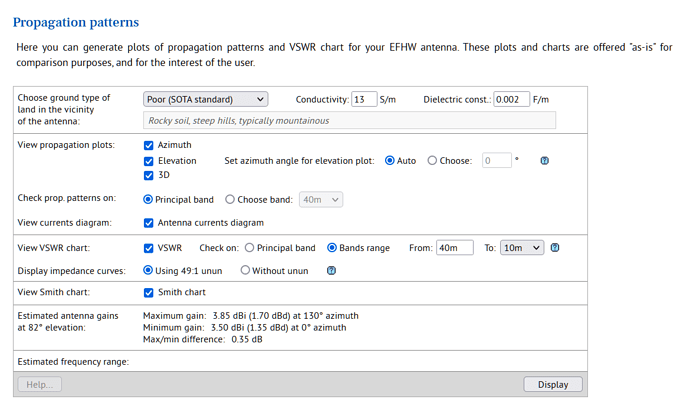Now, I need to preface this announcement with this observation: that I dislike calling attention to something I’ve developed and built myself, but it would seem that others are, understandably, even more reluctant to make the announcement themselves. So here goes…
There exists, for good or worse, a new wire-antenna design website aimed at portable radio activists. The site, to be found at
is still in development stage, but nonetheless works well enough to withstand some heavy use. Four different antenna types for HF use are currently supported:
- linked dipoles (this is intended to replace the SMP extras page Linked Dipole Designer)
- EFHW (end-fed half-wave) antennas
- vertically-polarized delta-loops
- half-square antennas
with a fifth - OCFD antennas - in development. All of these antenna types have been discussed in various Reflector threads, so they should be familiar to many.
Using any of the “designers” (i.e. one of the pages within the site), one can quickly specify an antenna of the designated type, experiment with various combinations of antenna section lengths or angles, choose from one of several ground types, and run a calculation which displays various antenna performance charts and diagrams. These diagrams include:
- azimuth, elevation and 3D propagation patterns
- VSWR curves, for one or several bands depending on antenna type, and including resistance and reactance (Re/Im) curves
- an antenna currents diagram
- a Smith chart
A couple of screenshots may whet the appetite for those interested in exploring what the site has to offer:
An example designer inputs area
An example designer options area
An example VSWR chart
What’s the point of this site?
It’s acknowledged that a number of NEC-based programs and apps exist, which can model antennas such as these (and a whole lot more besides!) but many would agree that they require a steep learning curve to become familiar with them to the point that they become less daunting to use, and many potential users are discouraged from using them.
Think of this new site as a “half-way” house which takes away a lot of the complexity of designing antennas like these, and yet still present NEC-based and NEC-calculated results. Be aware though, that since this is not a native executable optimized for a particular operating system, but runs in the interwebs, it runs rather more slowly than the optimized program … but it gets the job done. YMMV, as always.
More usefully, it serves as a “playground” where antenna specifications can be altered to see how propagation patterns, VSWR, etc. change with those alterations. Even if one doesn’t actually build the antenna, a lot can nonetheless be learned about antenna performance this way - I know I’ve learned a lot more than I did before about antenna performance and about antenna electrical properties while building and testing the site.
OK, that should do to start a few tongues wagging. Thanks for your time in casting a glance over this…
Cheers, Rob



